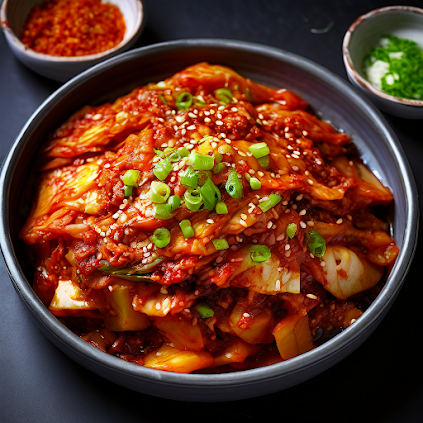Kimchi: Beyond the Spice - A Journey Through Korea's Fermented Masterpiece
Imagine a food so deeply ingrained in a culture that it's not just a side dish, but a symbol of national identity. A food that sparks passionate debates about the "right" way to make it, yet unites families around steaming bowls of savory goodness. A food that's fiery, funky, tangy, and surprisingly versatile – welcome to the world of kimchi.
For centuries, kimchi has been the vibrant heart of Korean cuisine. Fermented napa cabbage, radish, and other vegetables pulsate with life thanks to the magic of lactic acid bacteria. This humble side dish isn't just delicious; it's a powerhouse of probiotics, vitamins, and umami that elevate every meal.
But kimchi is more than just a fermented food. It's a living tradition, passed down through generations, evolving with each family's secret touch. In this article, we'll delve into the fascinating world of kimchi, exploring its history, varieties, health benefits, and modern iterations like vegan and whole-food kimchi.
A History Steeped in Tradition:
Kimchi's origins remain shrouded in mist, believed to date back to the Three Kingdoms period (37 BC to 668 AD). Back then, vegetables were salted and fermented to survive the harsh Korean winters. Over time, spices like ginger, garlic, and chili peppers were incorporated, giving birth to the kimchi we know today.
Each region in Korea boasts its own distinct kimchi style. The fiery red gochugaru (Korean chili flakes) of southern kimchi contrasts with the milder flavors of the north. Spicy, crunchy kkakdugi (radish kimchi) stands tall beside the mellow, watery dongchimi. This regional diversity reflects the adaptability of kimchi, embracing local ingredients and preferences.
Kimchi played a crucial role in Korean history. During wars and famines, it provided valuable nutrients and helped communities persevere. Even today, it remains a symbol of resilience and cultural pride. Korean emigrants carried kimchi across the globe, spreading its spicy charm and probiotic power to new shores.
Beyond the Fiery Red: A Universe of Kimchi Flavors:
While baechu kimchi, made with napa cabbage, is the most celebrated variety, the kimchi world is far more diverse. Here's a glimpse into some lesser-known, yet equally delicious, styles:
- Kkakdugi: Crunchy daikon radish kimchi, bursting with spicy and sour notes.
- Oi Kimchi: Cucumber kimchi, offering a refreshing and light counterpoint to bolder flavors.
- Nabak Kimchi: Watery kimchi with minimal spice, perfect for those who prefer a subtler touch.
- Jeon Kimchi: Kimchi pancakes, a crispy and comforting street food favorite.
- Kimchi Jjigae: A hearty stew featuring kimchi as the star ingredient, ideal for cold winter days.
And for the health-conscious foodies, vegan and whole-food kimchi options are gaining popularity. These variations use plant-based alternatives to fish sauce and rely on natural sweeteners, making them perfect for everyone to enjoy.
The Science Behind the Spice: Kimchi's Health Benefits:
Beyond its addictive flavor, kimchi packs a powerful punch of health benefits. The fermentation process generates lactic acid bacteria, the same "good" bacteria found in yogurt, which aids digestion and boosts the immune system.
Kimchi is also a rich source of vitamins A, C, and K, as well as dietary fiber. Studies suggest it may offer protection against certain cancers, lower cholesterol levels, and even improve brain function. In short, kimchi is a superfood in disguise, hiding its nutritional prowess under layers of deliciousness.
Modern Twists on an Ancient Tradition:
While tradition is deeply cherished, innovation isn't lost on the kimchi scene. Chefs worldwide are incorporating this versatile ingredient into their culinary creations. Kimchi fried rice remains a classic, but kimchi is now finding its way into pizzas, pastas, salads, and even cocktails.
The rise of veganism has sparked the creation of plant-based kimchi alternatives, while health-conscious foodies are experimenting with low-sodium and sugar-reduced versions. These adaptations prove that kimchi is a dynamic food, constantly evolving to cater to modern palates and dietary needs.





